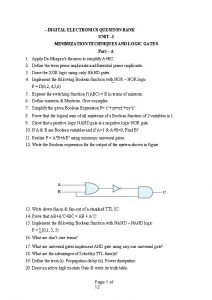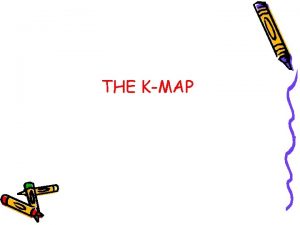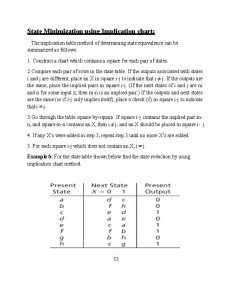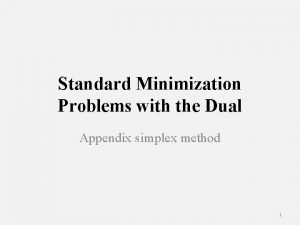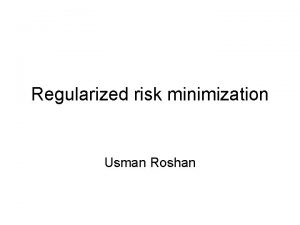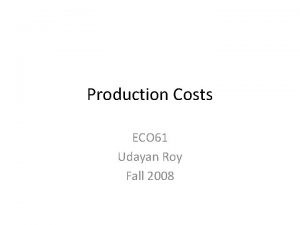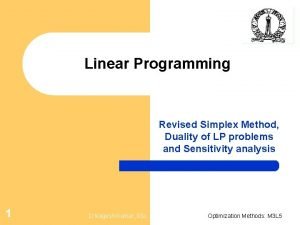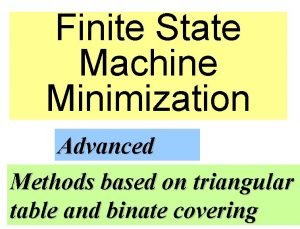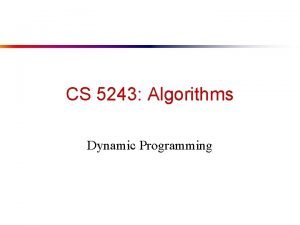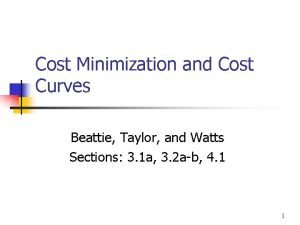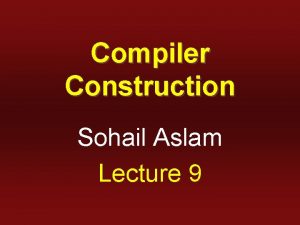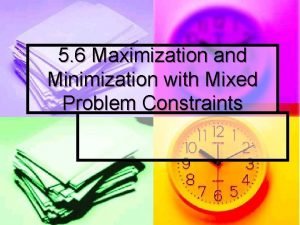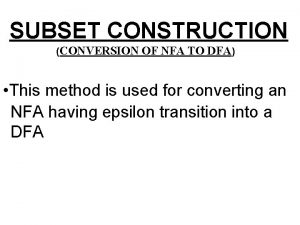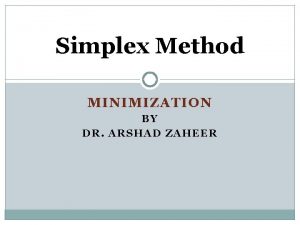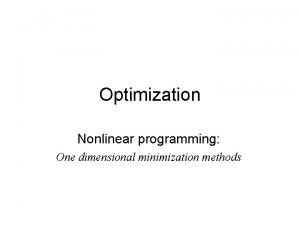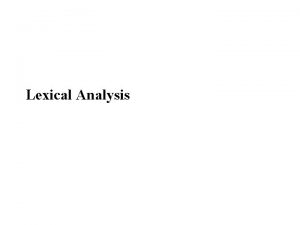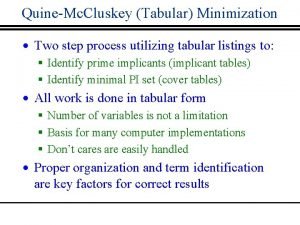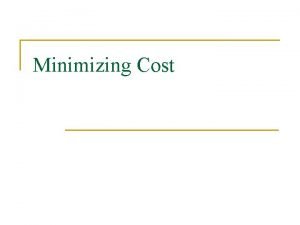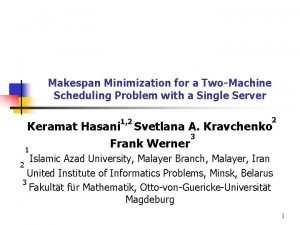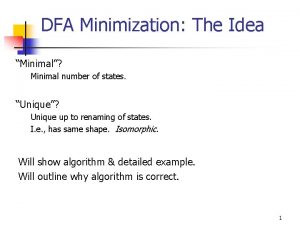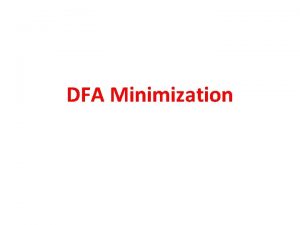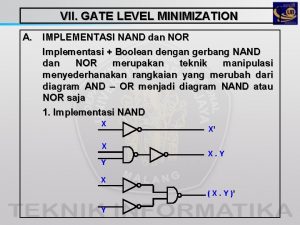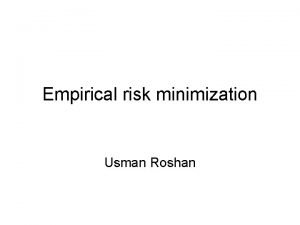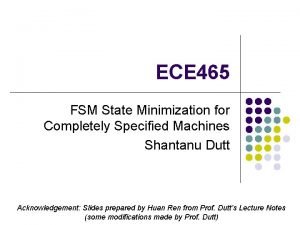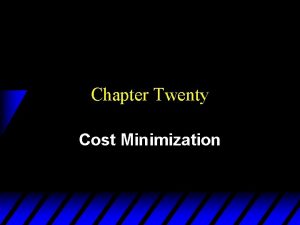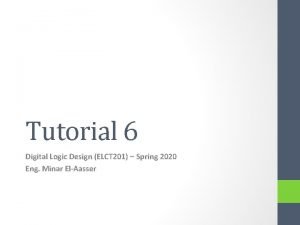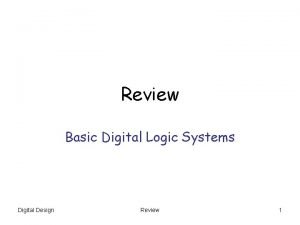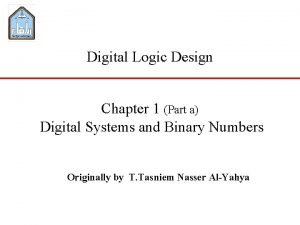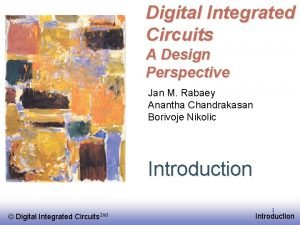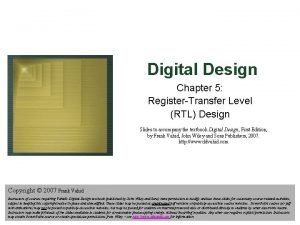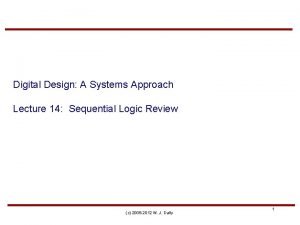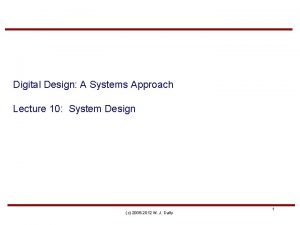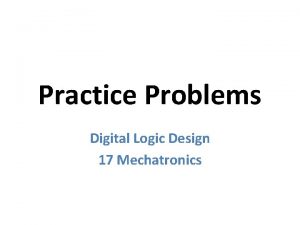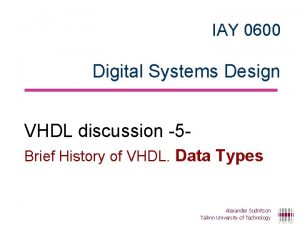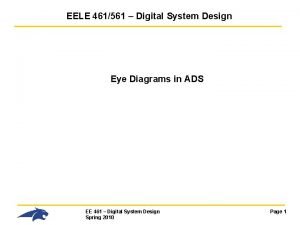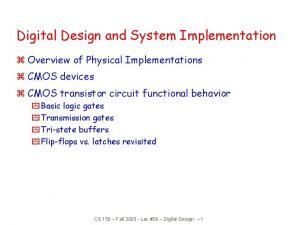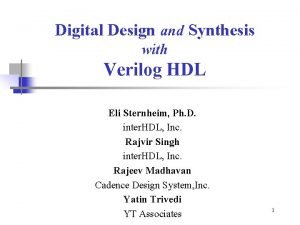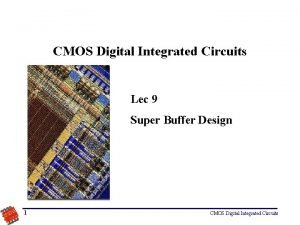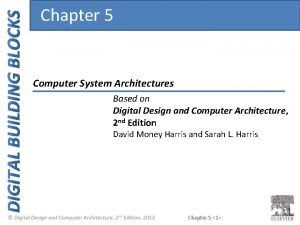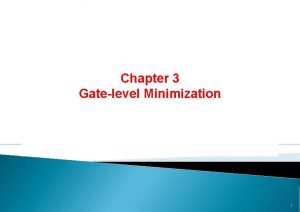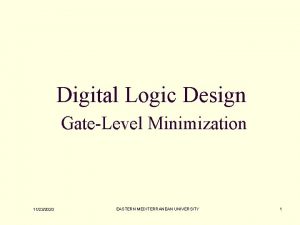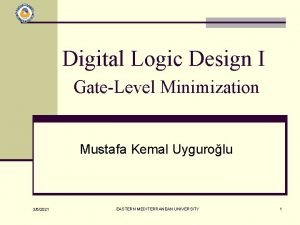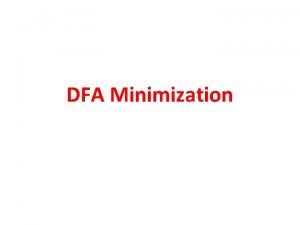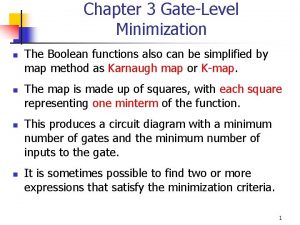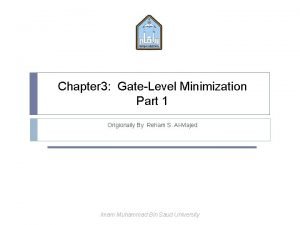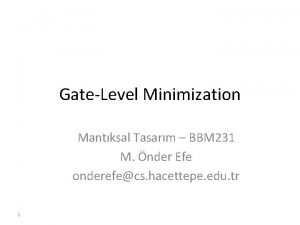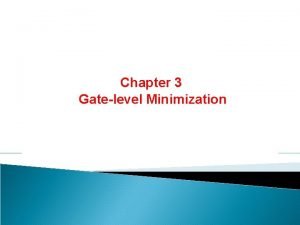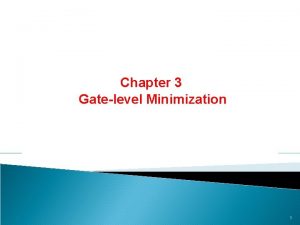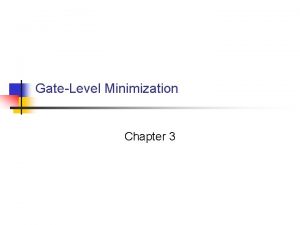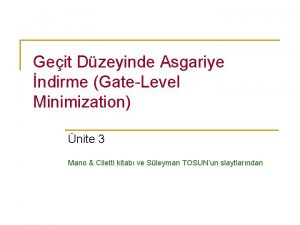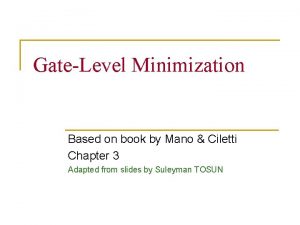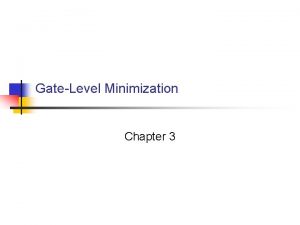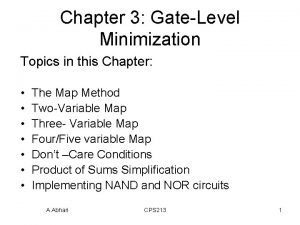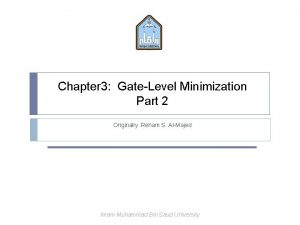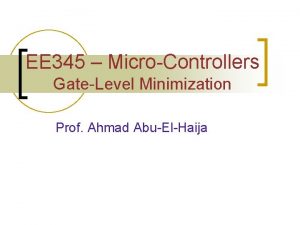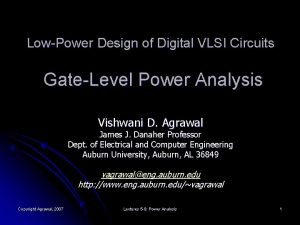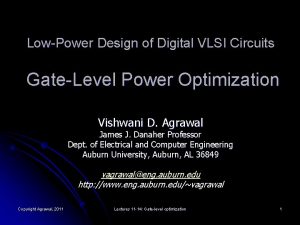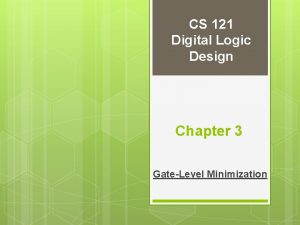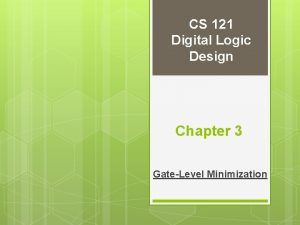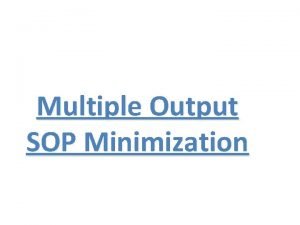DIGITAL LOGC DESIGN I GATELEVEL MINIMIZATION 3 1

























































- Slides: 57

DIGITAL LOGİC DESIGN I GATE-LEVEL MINIMIZATION

3 -1 INTRODUCTION Gate-level minimization refers to the design task of finding an optimal gate-level implementation of Boolean functions describing a digital circuit. The simplified algebraic expression produces a circuit diagram with a minimum number of gates and the minimum number of inputs to each gate (Minimum number of terms and literals) 2

3 -2 THE MAP METHOD Logic minimization Algebraic approaches: lack specific rules The Karnaugh map A simple straight forward procedure A pictorial ( )ﺗﺼﻮﻳﺮﻯ form of a truth table Applicable if the number of variables < 7 A diagram made up of squares Each square represents one minterm 3

REVIEW OF BOOLEAN FUNCTION Boolean function Sum of products (sum of minterms) or product of sum (product of maxterms) in the simplest form A minimum number of terms A minimum number of literals The simplified expression may not be unique 4

TWO-VARIABLE MAP A two-variable map Four minterms x' = row 0; x = row 1 y' = column 0; y = column 1 A truth table in square diagram Fig. 3. 2(a): xy = m 3 Fig. 3. 2(b): x+y = x'y+xy' +xy = m 1+m 2+m 3 Figure 3. 1 Two-variable Map 5 Figure 3. 2 Representation of functions in the map

A THREE-VARIABLE MAP A three-variable map Eight minterms The Gray code sequence Any two adjacent squares in the map differ by only on variable Primed in one square and unprimed in the other e. g. , m 5 and m 7 can be simplified m 5+ m 7 = xy'z + xyz = xz (y'+y) = xz 6 Figure 3. 3 Three-variable Map

A THREE-VARIABLE MAP m 0 and m 2 (m 4 and m 6) are adjacent m 0+ m 2 = x'y'z' + x'yz' = x'z' (y'+y) = x'z' m 4+ m 6 = xy'z' + xyz' = xz' (y'+y) = xz' y 7

EXAMPLE 3. 1 Example 3. 1: simplify the Boolean function F(x, y, z) = S(2, 3, 4, 5) F(x, y, z) = S(2, 3, 4, 5) = x'y + xy' Figure 3. 4 Map for Example 3. 1, F(x, y, z) = Σ(2, 3, 4, 5) = x'y + xy' 8

EXAMPLE 3. 2 Example 3. 2: simplify F(x, y, z) = S(3, 4, 6, 7) F(x, y, z) = S(3, 4, 6, 7) = yz+ xz' 9 Figure 3. 5 Map for Example 3 -2; F(x, y, z) = Σ(3, 4, 6, 7) = yz + xz'

FOUR ADJACENT SQUARES Consider four adjacent squares 4, and 8 squares m 0+m 2+m 4+m 6 = x'y'z'+x'yz'+xy'z'+xyz' = x'z'(y'+y) +xz'(y'+y) = x'z' + xz‘ = z' m 1+m 3+m 5+m 7 = x'y'z+x'yz+xy'z+xyz =x'z(y'+y) + xz(y'+y) =x'z + xz = z 2, 10 Figure 3. 3 Three-variable Map

One square represents one minterm with three literal. Two adjacent squares represent a term with two literal. Four adjacent squares represent a term with one literal. Eight adjacent squares produce a function that is always equal to 1. 11

EXAMPLE 3. 3 © Example 3. 3: simplify F(x, y, z) = S(0, 2, 4, 5, 6) = z'+ xy' 12 Figure 3. 6 Map for Example 3 -3, F(x, y, z) = Σ(0, 2, 4, 5, 6) = z' +xy'

EXAMPLE 3. 4 Example 3. 4: let F = A'C + A'B + AB'C + BC a) Express it in sum of minterms. b) Find the minimal sum of products expression. Ans: F(A, B, C) = S(1, 2, 3, 5, 7) = C + A'B Figure 3. 7 Map for Example 3. 4, A'C + A'B + AB'C + BC = C + A'B 13

3. 3 FOUR-VARIABLE MAP The map minterms Combinations of 2, 4, 8, and 16 adjacent squares 16 14 Figure 3. 8 Four-variable Map

One square represents one minterm with four literal. Two adjacent squares represent a term with three literal. Four adjacent squares represent a term with two literal. Eight adjacent squares represent a term with one literal. Sixteen adjacent squares produce a function that is always equal to 1. 15

EXAMPLE 3. 5 Example 3. 5: simplify F(w, x, y, z) = S(0, 1, 2, 4, 5, 6, 8, 9, 12, 13, 14) F = y'+w'z'+xz' 16 Figure 3. 9 Map for Example 3 -5; F(w, x, y, z) = Σ(0, 1, 2, 4, 5, 6, 8, 9, 12, 13, 14) = y' + w' z' +xz'

EXAMPLE 3. 6 Example 3 -6: simplify F = A B C + B CD + A BCD + AB C Figure 3. 9 Map for Example 3 -6; A B C + B CD + A B C D + AB C = B D + B C +A CD 17

PRIME IMPLICANTS In choosing adjacent squares in a map, we must ensure that: All the minterms are covered. Minimize the number of terms. t here is no redundant terms. (i. e. minterm, already covered by other terms) A prime implicant: a product term obtained by combining the maximum possible number of adjacent squares in the map. Essential P. I. : a minterm in a square is covered by only one prime implicant. The essential P. I. must be included. 18

PRIME IMPLICANTS Consider F(A, B, C, D) = Σ(0, 2, 3, 5, 7, 8, 9, 10, 11, 13, 15) The simplified expression may not be unique F = BD+B'D'+CD+AD = BD+B'D'+CD+AB' = BD+B'D'+B'C+AD = BD+B'D'+B'C+AB' 19 Figure 3. 11 Simplification Using Prime Implicants

3. 4 FIVE-VARIABLE MAP Map for more than four variables becomes complicated Five-variable map: two four-variable map (one on the top of the other). 20 Figure 3. 12 Five-variable Map

Table 3. 1 shows the relationship between the number of adjacent squares and the number of literals in the term. 21

EXAMPLE 3. 7 Example 3. 7: simplify F = S(0, 2, 4, 6, 9, 13, 21, 23, 25, 29, 31) 22 F = A'B'E'+BD'E+ACE

EXAMPLE 3. 7 (CONT. ) Another Map for Example 3 -7 23 Figure 3. 13 Map for Example 3. 7, F = A'B'E'+BD'E+ACE

3 -5 PRODUCT OF SUMS SIMPLIFICATION Simplified F' in the form of sum of products using the minterms marked with 0’s. Apply De. Morgan's theorem F = (F')' F': sum of products → F: product of sums 24

EXAMPLE 3. 8 © Example 3. 8: simplify F = S(0, 1, 2, 5, 8, 9, 10) into (a) sum-of-products form, and (b) product-of-sums form: a) F(A, B, C, D)= S(0, 1, 2, 5, 8, 9, 10) = B'D'+B'C'+A'C'D b) F' = AB+CD+BD' » Figure 3. 14 Map for Example 3. 8, F(A, B, C, D)= S(0, 1, 2, 5, 8, 9, 10) = B'D'+B'C'+A'C'D Apply De. Morgan's theorem; F=(A'+B')(C'+D')(B'+D) 25

EXAMPLE 3. 8 (CONT. ) Gate implementation of the function of Example 3. 8 Sum-of products form Product-of sums form Figure 3. 15 Gate Implementation of the Function of Example 3. 8 26

SUM-OF-MINTERM PROCEDURE Consider the function defined in Table 3. 2. In sum-of-minterm: In product-of-maxterm: 27

SUM-OF-MINTERM PROCEDURE Consider the function defined in Table 3. 2. Combine the 1’s: the 0’s : 0 ' Taking the complement of F Figure 3. 16 Map for the function of Table 3. 2 28

3 -6 DON'T-CARE CONDITIONS The value of a function is not specified for certain combinations of variables BCD; 1010 -1111: don't care Functions that have unspecified outputs for some input combinations are called incompletely specified functions. The don't-care conditions can be utilized in logic minimization Can be implemented as 0 or 1 Example 3. 9: simplify F(w, x, y, z) = S(1, 3, 7, 11, 15) which has the don't-care conditions d(w, x, y, z) = S(0, 2, 5). 29

EXAMPLE 3. 9 (CONT. ) F F = yz + w'x'; F = yz + w'z = S(0, 1, 2, 3, 7, 11, 15) ; F = S(1, 3, 5, 7, 11, 15) Either expression is acceptable 30 Figure 3. 17 Example with don't-care Conditions

3 -7 NAND NOR IMPLEMENTATION NAND gate is a universal gate Can implement any digital system 31 Figure 3. 18 Logic Operations with NAND Gates

NAND GATE Two graphic symbols for a NAND gate Figure 3. 19 Two Graphic Symbols for NAND Gate 32

TWO-LEVEL IMPLEMENTATION Two-level logic NAND-NAND = sum of products Example: F = AB+CD F = ((AB)' (CD)' )' =AB+CD 33 Figure 3. 20 Three ways to implement F = AB + CD

EXAMPLE 3. 10 Example 3 -10: implement F(x, y, z) with NAND gate 34 Figure 3. 21 Solution to Example 3 -10

PROCEDURE WITH TWO LEVELS NAND The procedure Simplified in the form of sum of products; A NAND gate for each product term; the inputs to each NAND gate are the literals of the term (the first level); A single NAND gate for the second sum term (the second level); A term with a single literal requires an inverter in the first level. If it is complemented, it can be connected directly to an input of the second-level NAND gate. 35

MULTILEVEL NAND CIRCUITS Boolean function implementation AND-OR logic → NAND-NAND logic AND → AND + inverter = NAND OR: inverter + OR = NAND For every bubble that is not compensated by another small circle along the same line, insert an inverter or complement the input literal. Figure 3. 22 Implementing F = A(CD + B) + BC 36

NAND IMPLEMENTATION 37 Figure 3. 23 Implementing F = (AB +A B)(C+ D )

NOR IMPLEMENTATION NOR function is the dual of NAND function. The NOR gate is also universal gate. 38 Figure 3. 24 Logic Operation with NOR Gates

TWO GRAPHIC SYMBOLS FOR A NOR GATE THE FUNCTION MUST BE SIMPLIFIED IN THE FORM OF SUM OF PRODUCTS; Figure 3. 25 Two Graphic Symbols for NOR Gate Example: F = (A + B)(C + D)E 39 Figure 3. 26 Implementing F = (A + B)(C + D)E

EXAMPLE Example: F = (AB +A B)(C + D ) Figure 3. 27 Implementing F = (AB +A B)(C + D ) with NOR gates 40

THE PROBLEMS OF CHAPTER THREE : 3. 4, 3. 6, 3. 8, 3. 9, 3. 11, 3. 13, 3. 15, 3. 16, 3. 19,

NON-DEGENERATE FORMS We consider four types of gates : AND, OR, NAND and NOR. 16 possible combinations of two-level forms Eight AND-AND, AND-NAND, OR-OR, OR-NOR, NAND-NOR, NOR-AND, NORNAND. The of them: degenerate forms = a single operation eight non-degenerate forms AND-OR, OR-AND, NAND-NAND, NOR-NOR, NOR-OR, NAND-AND, OR-NAND, AND-NOR. 42

AND-OR and NAND-NAND = sum of products. OR-AND and NOR-NOR = product of sums. NOR-OR, NAND-AND, OR-NAND, AND-NOR = ?

Examples of degenerate forms 44

AND-OR-INVERT IMPLEMENTATION (AND-NOR) AND-OR-INVERT (AOI) Implementation AND-NOR = AOI = NAND-AND F = (AB+CD+E)' F' = AB+CD+E (sum of products) Figure 3. 29 AND-OR-INVERT circuits, F = (AB +CD +E) 45

OR-AND-INVERT IMPLEMENTATION (ORNAND) OR-AND-INVERT (OAI) Implementation OR-NAND = NOR-OR = OAI F = ((A+B)(C+D)E)' F' = (A+B)(C+D)E (product of sums) 46 Figure 3. 30 OR-AND-INVERT circuits, F = ((A+B)(C+D)E)'

TABULAR SUMMARY AND EXAMPLES 47

48 Figure 3. 31 Other Two-level Implementations

3 -9 EXCLUSIVE-OR FUNCTION Exclusive-OR (XOR) xÅy = xy'+x'y Exclusive-NOR (XNOR) (xÅy)' = (x'+y)(x+y')=xy + x'y' Some identities xÅ0 =x xÅ1 = x' xÅx = 0 xÅx' = 1 xÅy' = (xÅy)' = x'Åy Commutative and associative AÅB = BÅA (AÅB) ÅC = AÅ (BÅC) = AÅBÅC 49

EXCLUSIVE-OR IMPLEMENTATIONS Implementations xy'+x'y = xÅy = xy'+x'y+xx’+yy’ = (x'+y')x + (x'+y')y (x'+y') = (xy)' 50 Figure 3. 32 Exclusive-OR Implementations

ODD FUNCTION AÅBÅC = (AB'+A'B)C' + (AB+A'B')C = AB'C'+A'BC'+ABC+A'B'C = S(1, 2, 4, 7) XOR is a odd function → an odd number of 1's, then F = 1. XNOR is a even function → an even number of 1's, then F = 1. 51 Figure 3. 33 Map for a Three-variable Exclusive-OR Function

XOR AND XNOR Logic diagram of odd and even functions Figure 3. 34 Logic Diagram of Odd and Even Functions 52

FOUR-VARIABLE EXCLUSIVE-OR FUNCTION Four-variable Exclusive-OR function AÅBÅCÅD = (AB'+A'B)Å(CD'+C'D) = (AB'+A'B)(CD+C'D')+(AB+A'B')(CD'+C'D) 53 Figure 3. 35 Map for a Four-variable Exclusive-OR Function

PARITY GENERATION AND CHECKING Parity Generation and Checking A parity bit: P = xÅyÅz Parity check: C = xÅyÅzÅP C=1: one bit error or an odd number of data bit error C=0: correct or an even # of data bit error 54 Figure 3. 36 Logic Diagram of a Parity Generator and Checker

PARITY GENERATION AND CHECKING 55

PARITY GENERATION AND CHECKING 56

THE PROBLEMS: 3. 24, 3. 25, 3. 26, 3. 27, 3. 28
 Digital electronics question bank
Digital electronics question bank Mapa de karnaugh 4 variables
Mapa de karnaugh 4 variables Implication table method
Implication table method Minimization problem example
Minimization problem example Expected risk minimization
Expected risk minimization Cost minimization formula
Cost minimization formula Dual simplex method example
Dual simplex method example Finite state machine minimization
Finite state machine minimization Cost minimization formula
Cost minimization formula Cost minimization
Cost minimization Dfa minimization code in c++
Dfa minimization code in c++ Big m method minimization example
Big m method minimization example Subset construction algorithm
Subset construction algorithm Simplex method minimization
Simplex method minimization One dimensional minimization methods
One dimensional minimization methods Dfa minimization
Dfa minimization Tabular method of minimization
Tabular method of minimization Cost minimization problem
Cost minimization problem Makespan minimization
Makespan minimization Cp meaning psychology
Cp meaning psychology Dfa minimization examples
Dfa minimization examples Dominos recall
Dominos recall Nand xx
Nand xx Cost minimization analysis
Cost minimization analysis Empirical risk minimization python
Empirical risk minimization python State minimization partitioning method
State minimization partitioning method Risk minimization plan
Risk minimization plan Cost minimization perfect complements
Cost minimization perfect complements Apa yang dimaksud dengan warga digital
Apa yang dimaksud dengan warga digital E-commerce digital markets digital goods
E-commerce digital markets digital goods Digital data digital signals
Digital data digital signals Data encoding and modulation
Data encoding and modulation E-commerce: digital markets, digital goods
E-commerce: digital markets, digital goods Signal encoding techniques in data communication
Signal encoding techniques in data communication Healthtech mobility
Healthtech mobility E-commerce digital markets digital goods
E-commerce digital markets digital goods Digital logic design tutorial
Digital logic design tutorial Bubble matching digital logic
Bubble matching digital logic Digital systems testing and testable design
Digital systems testing and testable design Digital design and computer architecture
Digital design and computer architecture Digital logic design number system
Digital logic design number system Jan m rabaey digital integrated circuits
Jan m rabaey digital integrated circuits Digital integrated circuits: a design perspective
Digital integrated circuits: a design perspective Frank final what be
Frank final what be Digital design a systems approach
Digital design a systems approach Digital design: a systems approach
Digital design: a systems approach Digital system design using verilog
Digital system design using verilog Digital logic design practice problems
Digital logic design practice problems Digital system design with vhdl
Digital system design with vhdl Vhdl
Vhdl Digital system design
Digital system design Digital design and computer architecture
Digital design and computer architecture Digital didaktisk design
Digital didaktisk design Digital design z
Digital design z Verilog
Verilog Digital design methodology
Digital design methodology In cmos inverters super buffers have
In cmos inverters super buffers have Digital design and computer architecture
Digital design and computer architecture
